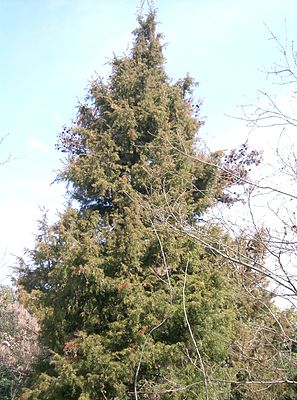Hedgehog juniper
| Hedgehog juniper | ||||||||||||
|---|---|---|---|---|---|---|---|---|---|---|---|---|

Hedgehog Juniper ( Juniperus rigida ) |
||||||||||||
| Systematics | ||||||||||||
|
||||||||||||
| Scientific name | ||||||||||||
| Juniperus rigida | ||||||||||||
| Siebold & Zucc. |
The Hedgehog juniper ( Juniperus rigida ) is a plant from the family of the cypress family (Cupressaceae). It is native to China, Eastern Russia, Korea, and Japan.
description
The hedgehog juniper grows as an evergreen shrub or small tree that can reach heights of up to 10 meters and diameters of up to 45 centimeters at chest height . The thin and scaly bark of young trees is brown in color. As it ages, it turns gray and becomes furrowed. The crown is pyramidal or cylindrical in shape and is formed by branches that descend straight or ascending from the trunk. The hanging, thin branches have a triangular cross section and a reddish brown, hairless bark .
The dark green, rigid needles are 1 to 2.8 centimeters long and around 1 millimeter wide and are shaped like a linear needle. The three of them stand together in whorls . Their cross-section is V-shaped. The tip is pointed and prickly. The underside of the needle is deeply keeled and there is a narrow, white stoma band on the upper side of the needle .
The hedgehog juniper is dioecious ( dioecious ), only rarely monoecious ( monoecious ). The flowering period includes the month of April; the seeds ripen towards the end of the second or summer of the third year. The yellowish-green male cones are spherical to elliptical in shape with a diameter of 3 to 5 millimeters. They stand together in three whorls and contain nine to twelve microsporophylls , each with four to seven pollen sacs . The short-stalked, berry-shaped cones are spherical to ovoid with a diameter of 6 to 10 millimeters. The stems are densely covered with small scale leaves. Initially the cones are colored green. As they ripen, they change color to light brown, blue or blue-black with a blue-green tint and give off a strong resinous odor . Each cone contains two to three brown seeds. The resinous seeds are elongated to triangular in shape with a length of around 6 millimeters and a width of around 3 millimeters. Each seed has three to four teeth.
The number of chromosomes is 2n = 22.
Distribution and location
The natural range of the hedgehog juniper is in China, Korea, Southeast Russia and Japan. It occurs in China in the provinces of Gansu , North Hebei , Heilongjiang , Jilin , Liaoning , Nei Mongol , Ningxia , Qinghai , Shanxi and Shaanxi . In Japan, the distribution area includes the islands of Hokkaidō , Honshū , North Shikoku , North and Central Kyushu and also the Ryūkyū Islands . In Russia, the species is found in the southern Primorye region , on Kamchatka and Sakhalin .
The hedgehog juniper thrives at altitudes of 100 to 2200 meters. There it grows mainly in dry mountain areas and on the coast of the sea on limestone and sandy soils.
use
The hedgehog juniper is planted as an ornamental wood, among other things.
Systematics
It was first described as Juniperus rigida in 1846 by Philipp Franz von Siebold and Joseph Gerhard Zuccarini in "Treatises of the Mathematical-Physical Class of the Royal Bavarian Academy of Sciences", Volume 4 (3), page 233. A synonym for Juniperus rigida Siebold & Zucc. is Juniperus utilis Koidz.
The species is divided into up to two subspecies:
- Juniperus rigida subsp. conferta (Parl.) Kitami occurs in China, on Sakhalin, Hokkaido, Honshu and Kyushu. Synonyms are Juniperus conferta Parl. And Juniperus rigida var. Conferta (Parl.) Patschke .
- Juniperus rigida subsp. rigida is the nominate form. It occurs in China, Japan, Korea, Far Eastern Russia and the Ryūkyū Islands .
Hazard and protection
The hedgehog juniper is listed on the IUCN Red List as “not endangered”. It is pointed out, however, that a new review of the hazard is necessary.
swell
- Christopher J. Earle: Juniperus rigida. In: The Gymnosperm Database. conifers.org, December 12, 2010, accessed January 8, 2012 .
- Liguo Fu, Yong-fu Yu, Robert P. Adams & Aljos Farjon: Cupressaceae . Juniperus. In: Wu Zhengyi, Peter H. Raven & Hong Deyuan (eds.): Flora of China . Cycadaceae through Fagaceae. Volume 4. Science Press and Missouri Botanical Garden Press, Beijing / St. Louis 1999, ISBN 0-915279-70-3 , Juniperus rigida , pp. 71 (English, Juniperus rigida - online - this printed work is online with the same text).
Individual evidence
- ↑ a b c d e f Christopher J. Earle: Juniperus rigida. In: The Gymnosperm Database. www.conifers.org, December 12, 2010, accessed January 8, 2012 .
- ^ A b c Liguo Fu, Yong-fu Yu, Robert P. Adams & Aljos Farjon: Cupressaceae . Juniperus. In: Wu Zhengyi, Peter H. Raven, Hong Deyuan (eds.): Flora of China . Cycadaceae through Fagaceae. Volume 4. Science Press and Missouri Botanical Garden Press, Beijing / St. Louis 1999, ISBN 0-915279-70-3 , Juniperus rigida , pp. 71 (English, Juniperus rigida - this printed work is online with the same text).
- ↑ a b c d Juniperus rigida. In: Germplasm Resources Information Network. www.ars-grin.gov, accessed on January 8, 2012 (English).
- ↑ a b Juniperus rigida at Tropicos.org. Missouri Botanical Garden, St. Louis, accessed January 8, 2012.
- ↑ Rafaël Govaerts (ed.): Juniperus. In: World Checklist of Selected Plant Families (WCSP) - The Board of Trustees of the Royal Botanic Gardens, Kew . Retrieved March 26, 2019.
- ↑ Juniperus rigida in the endangered Red List species the IUCN 2011. Posted by: Conifer Specialist Group, 1998. Accessed January 8, 2012th
